Your Online Source for Wholesale Diamonds


A Diamond is the hardest natural material known to man and the third-hardest known material after aggregated diamond nanorods and ultrahard fullerite. Its hardness and high dispersion of light make it useful for industrial applications and jewelry.
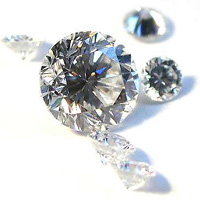
Diamonds are specifically renowned as a material with superlative physical qualities, they make excellent abrasives because they can be scratched only by other diamonds, Borazon, ultrahard fullerite, or aggregated diamond nanorods, which also means they hold a polish extremely well and retain their lustre. About 130 million carats (26,000 kg) are mined annually, with a total value of nearly USD $9 billion. About 100,000 kg are synthesized annually.
The name diamond derives from the ancient Greek adamas (αδ?μας "invincible"). They have been treasured as gemstones since their use as religious icons in ancient India and usage in engraving tools also dates to early human history. Popularity of diamonds has risen since the 19th century because of increased supply, improved cutting and polishing techniques, growth in the world economy, and innovative and successful advertising campaigns. They are commonly judged by the "Four C’s": carat, clarity, color, and cut.
Roughly 49% of diamonds originate from central and southern Africa, although significant sources of the mineral have been discovered in Canada, India, Russia, Brazil, and Australia. They are mined from kimberlite and lamproite volcanic pipes, which brought to the surface the diamond crystals from deep in the Earth where the high pressure and temperature enables the formation of the crystals. The mining and distribution of natural diamonds are subjects of frequent controversy such as with concerns over the sale of conflict diamonds by African paramilitary groups. There are also allegations that the De Beers Group misuses its dominance in the industry to control supply and manipulate price via monopolistic practices, although in recent years the company's market share has dropped to below 50%.
Natural Fancy Yellow Color Diamond
Diagram of Fancy Colored Diamonds(Canary)
Range from Vivid to Light
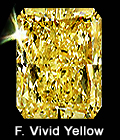
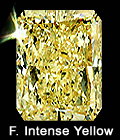
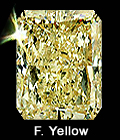
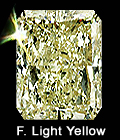
Diagram of Non-fancy Diamond
Range from Z - U
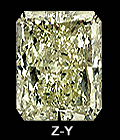
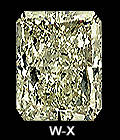
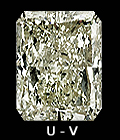
Most diamonds used as gemstones are basically transparent with little tint, or white diamonds. The most common impurity, nitrogen, replaces a small proportion of carbon atoms in a diamond's structure and causes a yellowish to brownish tint.
Beautiful yellow diamonds exist in tones from light yellow to fancy intense vivid yellow, also named Canary Yellow, depending on the concentration of nitrogen when the crystal is formed. Yellow diamonds are more desirable than white diamonds, due to their warm color. In fancy diamonds, inclusions are mostly not noticeable to the naked eye because of its rich color, inclusions does not affect the look or its sparkles not like in clear diamonds.
Natural fancy coloured diamonds are very rare and expensive. Most people believe that yellow diamonds are less desirable and valuable than white diamonds. While this is true of faintly coloured or off-white diamonds, intensely coloured diamonds are very attractive, rare and expensive. The Kimberley Octahedron is the largest diamond in the world at about 616 carats, and is yellow.
Grading fancy color diamonds
Yellow or brown color diamonds having color more intense than "Z", as well as diamonds exhibiting color other than yellow or brown are considered fancy colored diamonds. These diamonds are graded using separate systems which indicate the characteristics of the color, and not just its presence. These color grading systems are similar to those used for other colored gemstones, such as ruby, sapphire, or emerald, than they are to the system used for white diamonds.
GIA colored diamond grading system
The GIA issues grading a Colored Diamond Grading Report for colors that are not in the normal color range of diamonds. Formal GIA terms used to describe natural yellow diamonds:
|
Gran Colorimeter |
|
Color can also be determined using a device called the Gran Colorimeter, manufactured by Sarin Technologies. It measures from D to Z to Fancy Intense with an accuracy within ±½ of a color grade on loose stones from 0.25 to 10 carats (as low as .15 carat or as high as 20 carats with reduced accuracy), and you can specify which grading scale it should use (GIA, GEM, IGI, AGS, HRD, and others). The accuracy is within ±1 color grade for mounted stones. If you diamond is a "G" color it will tell you whether it's a "high G" or a "low G." The Gran colorimeter was first developed by Paul Gran in 1972 at Gran Computer Industries Ltd. |
Natural Fancy Yellow Color Diamond
Diagram of Fancy Colored Diamonds(Canary)
Range from Vivid to Light




Diagram of Non-fancy Diamond
Range from Z - U



Most diamonds used as gemstones are basically transparent with little tint, or white diamonds. The most common impurity, nitrogen, replaces a small proportion of carbon atoms in a diamond's structure and causes a yellowish to brownish tint.
Beautiful yellow diamonds exist in tones from light yellow to fancy intense vivid yellow, also named Canary Yellow, depending on the concentration of nitrogen when the crystal is formed. Yellow diamonds are more desirable than white diamonds, due to their warm color. In fancy diamonds, inclusions are mostly not noticeable to the naked eye because of its rich color, inclusions does not affect the look or its sparkles not like in clear diamonds.
Natural fancy coloured diamonds are very rare and expensive. Most people believe that yellow diamonds are less desirable and valuable than white diamonds. While this is true of faintly coloured or off-white diamonds, intensely coloured diamonds are very attractive, rare and expensive. The Kimberley Octahedron is the largest diamond in the world at about 616 carats, and is yellow.
Grading fancy color diamonds
Yellow or brown color diamonds having color more intense than "Z", as well as diamonds exhibiting color other than yellow or brown are considered fancy colored diamonds. These diamonds are graded using separate systems which indicate the characteristics of the color, and not just its presence. These color grading systems are similar to those used for other colored gemstones, such as ruby, sapphire, or emerald, than they are to the system used for white diamonds.
GIA colored diamond grading system
The GIA issues grading a Colored Diamond Grading Report for colors that are not in the normal color range of diamonds. Formal GIA terms used to describe natural yellow diamonds:
|
Gran Colorimeter |
|
Color can also be determined using a device called the Gran Colorimeter, manufactured by Sarin Technologies. It measures from D to Z to Fancy Intense with an accuracy within ±½ of a color grade on loose stones from 0.25 to 10 carats (as low as .15 carat or as high as 20 carats with reduced accuracy), and you can specify which grading scale it should use (GIA, GEM, IGI, AGS, HRD, and others). The accuracy is within ±1 color grade for mounted stones. If you diamond is a "G" color it will tell you whether it's a "high G" or a "low G." The Gran colorimeter was first developed by Paul Gran in 1972 at Gran Computer Industries Ltd. |